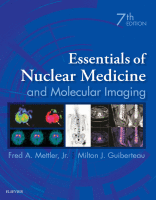Physical Address
304 North Cardinal St.
Dorchester Center, MA 02124

You’re Reading a Preview Become a Clinical Tree membership for Full access and enjoy Unlimited articles Become membership If you are a member. Log in here

You’re Reading a Preview Become a Clinical Tree membership for Full access and enjoy Unlimited articles Become membership If you are a member. Log in here

Answers to Unknown Case Sets Case 1.1 1.1a. What is the most likely diagnosis? Unobstructed patulous collecting system of the right kidney with prompt washout of activity from the collecting system after Lasix. 1.1b. If 370 MBq (10 mCi) of 99m TcO…

The following case sets have been designed to assess your overall knowledge in nuclear imaging. Each set contains 10 cases, and almost all sets have an example of central nervous system, thyroid, cardiac, respiratory, gastrointestinal, musculoskeletal, tumor, or abscess and…

Overview In the United States, personnel qualifications and safety requirements for the medical use of radioisotopes as they apply to the practitioners of clinical nuclear medicine are set nationally by the US Nuclear Regulatory Commission (NRC). These may be found…

A variety of nuclear medicine imaging techniques provide effective methods for the detection and assessment of both clinically apparent and occult infectious and inflammatory conditions. Rather than representing organ-specific techniques, these procedures use radiopharmaceuticals that localize preferentially in inflamed or…

18 F-FDG PET Imaging Positron emission tomography (PET) in clinical practice is performed using the hybrid instrumentations of PET/computed tomography (CT) and, to a lesser extent, PET/magnetic resonance imaging (MRI). The most commonly used radiopharmaceutical is fluorine-18 fluorodeoxyglucose ( 18…

In this chapter, tumor imaging using conventional gamma camera techniques including single-photon emission computed tomography (SPECT) and SPECT/computed tomography (SPECT/CT) as well as less frequently employed or emerging radionuclide tumor therapies are addressed. The more commonly encountered entities of thyroid…

Radionuclide evaluation of the genitourinary system includes quantitative estimates of renal perfusion and function. With the widespread use of magnetic resonance imaging (MRI), computed tomography (CT), angiography, and Doppler ultrasound, the evaluation of renal anatomy by nuclear techniques has diminished,…

The ready availability of cost-effective technetium-labeled bone-seeking radiopharmaceuticals allows the widespread use of bone scanning for both regional and whole-body skeletal assessment in the evaluation of a variety of benign and malignant disease states. The bone scan often provides an…